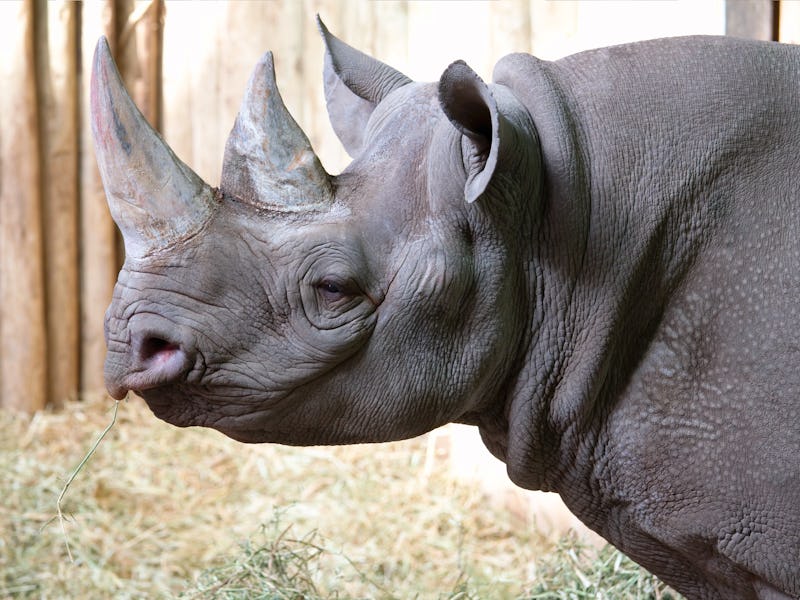3D-Printed Rhino Horns, Like Synthetic Diamonds, Will Expand the Black Market
Rhino horns are a luxury good and a public "Fuck You!" to the law. Flooding the market isn't going to change that.

Comb through the back alleys of Hanoi’s oldest marketplaces and you’ll likely find contraband rhinoceros horn: smuggled from Africa, freshly cut, worth more than ivory or gold. Pay a visit to Pembient’s Seattle headquarters, and you’ll find the exact same thing. The activist biofabrication company 3D-prints ceros (latin for horn) using protein keratin. The man made horns are considerably less expensive, despite the impressive science behind the process. This is by design. Pembient wants to create affordable facsimiles in order to drive down the price of horns on the black market and save endangered species.
It’s a bold idea and — if past is prelude — a very bad one.
The problem, it should be reiterated, is not technological. The lab-grown horns are physically identical to the real thing. But the problem facing rhinos has never really been the value of their facial adornments. The force keeping prices high has always been cultural. Rhino horns are valuable because of what they represent, and you can’t 3D print status.
Now would be a good time to recall the rise of the synthetic diamond. The lab-grown gems are characterized by the World Jewelry Federation as a “man-made reproduction of a diamond that has essentially the same chemical composition, crystal structure and physical properties as its natural counterpart.” But just because the gems are fundamentally the same doesn’t mean they’re equally valuable. When synthetic gems emerged on the market, activists and non-assholes hoped they’d reduce demand for blood diamonds. But a new grading hierarchy fell into place, forcing jewelers to inform their customers when a diamond is synthetic.
This rule didn’t just protect profits for companies like Rio Tinto and Russia’s ALROSA. The rule meant that there were more diamonds in the world and a smaller percentage of diamonds people deemed worth considerable sums of money. Research by De Beers has demonstrated that most consumers were and are unwilling to settle for synthetics. Diamonds were further embedded into the culture by virtue of becoming accessible to a broader market even as products at the high end of that market maintained or increased their value. Shlomo Tidhar, CEO of the Singapore Diamond Exchange, explained the situation thusly: “I believe it will be very hard for me as a man to buy a woman I love a synthetic diamond.”
Like diamonds, rhino horns can be a very big deal. In Vietnam as well as in China, the horns are status symbols among society’s wealthy elite, carved into items such as jewelry, chopsticks, and cups and displayed proudly, a public fuck-you to the law. Their scarcity also adds to their mystique: shaved, powdered, and stirred into elixirs, rhino horn is thought to be a rare cure-all for everything from cancer to impotence to hangovers. When buyers shell out $20,000 to $60,000 a kilogram for the stuff — that’s about the same range as Colombian cocaine — they’re buying chunks of keratin, but they’re paying for authenticity.
There is no rhino horn equivalent of the World Jewelry Federation — at least not one that’s publicly known — but it would be foolish to think that those controlling the industry wouldn’t be able to find a way to differentiate their goods from Pembient’s genetically identical ones, especially knowing that their customers would pay for a guarantee of authenticity (ironically, the company has described itself as “the De Beers of Synthetic Wildlife Products”). Pembient has addressed this, saying “it is not clear how real horn will be identified and awarded a premium in the market.” While the how of the thing isn’t clear — yet — there’s little doubt that it’ll happen.
Even now, imitation rhino horns — hollow buffalo or cattle horns, filled with wood and dry bamboo root — sell for $15,000 a kilogram, suggesting that its price is, indeed, being controlled. Pembient has suggested selling their goods into the market as an official “alternative” to rhino horn, calling their product “a better and more humane” alternative. That should end about as well for the company as Blood Diamond did for Leo.
Luxury items are expensive and arbitrarily so. Diamonds are just rocks in the ground. Rhino horns are made from the same stuff as our fingernails. But what both of these things are is rare (and getting rarer). They are valuable for that reason and only that reason. The physical qualities of diamonds and horns are irrelevant. If they become less rare, people will find a way to break down the market to make them rare again.
Or they’ll find something even rarer.